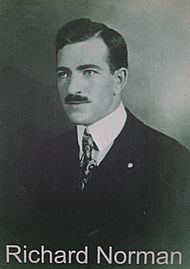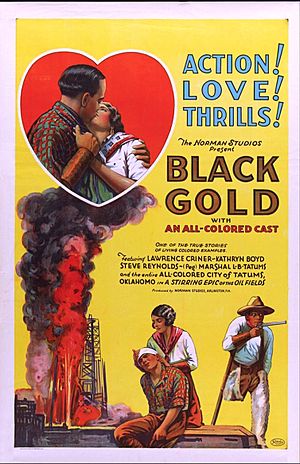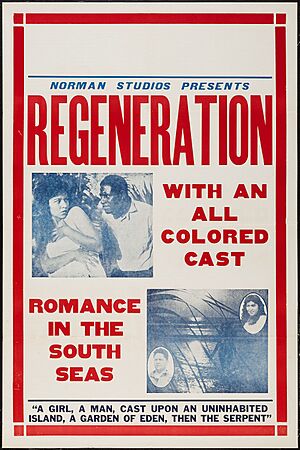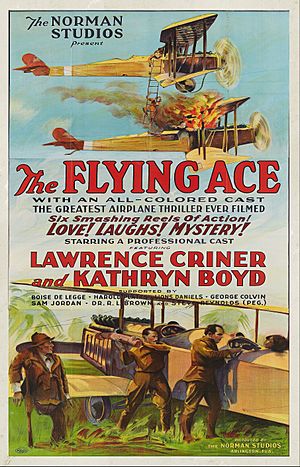Norman Studios facts for kids
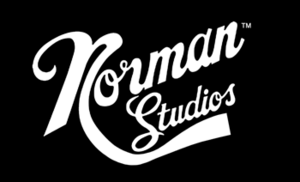 |
|
| Established | 1920 |
|---|---|
| Location | Arlington, Jacksonville, Florida, United States |
| Type | Film |
Norman Studios, also known as Norman Film Manufacturing Company, was an important American film studio located in Jacksonville, Florida. It was started by Richard Edward Norman. From 1919 to 1928, the studio made silent films that featured African-American actors.
Norman Studios is the only film studio from that early time in Jacksonville that is still standing. Today, its buildings are home to the Norman Studios Silent Film Museum. This studio was one of the most famous places making movies for Black audiences during the silent film era. Norman's movies showed Black characters in positive and strong roles.
The studio made eight full-length movies and many short films. Its most famous movie, The Flying Ace, is the only one that still exists. It has been carefully restored by the Library of Congress. After "talking pictures" became popular, Norman Studios stopped making films. Its old technology was no longer useful. The studio then focused on distributing and promoting movies before it finally closed. In recent years, the studio's buildings were fixed up and turned into a museum. On October 31, 2016, the studio was named a National Historic Landmark.
History of Norman Studios
Jacksonville: The Film City
In the early 1900s, the movie industry was growing fast. Many film companies moved from New York to Northeast Florida. They did this so they could keep filming movies even during the winter. Jacksonville became known as the "Winter Film Capital of the World." From 1908 to 1922, more than thirty silent film studios were in the city.
The buildings that would become Norman Studios were first built in 1916. They were part of a company called Eagle Film Studios. However, Eagle Film Studios went out of business a few years later.
Richard Norman's Journey
Richard Edward Norman was born in Middleburg, Florida in 1891. He started his movie career in the Midwest in the 1910s. At first, he made movies for white audiences. He would travel to different towns with some film clips and a basic story. He would then ask local people to act in small parts. They would film a short new part of the movie over a few days. These movies were called "home talent" films.
After the films were ready, they were shown in the towns. Norman shared the money earned with the town. This led him to film other events and plays. His first silent film with an all-Black cast was The Green-Eyed Monster (1919). This movie was about the railroad industry. It told a dramatic story of greed and jealousy.
Norman later split this film into two parts: a drama called Green-Eyed Monster and a comedy called Love Bug. These two films did much better. In 1920, when he was 29, Norman moved to Jacksonville. He bought the old Eagle Film Studios buildings. The success of his films made other African-American actors want to work with him.
Making "Race Films"
During the 1920s, movies made with African-American actors and shown mainly to African-American audiences were called "race films". Norman Studios made several of these films. Richard Norman chose to make race films not just for business reasons. He saw that there was a need for these movies. He also wanted to help improve race relations at the time. Many talented Black performers could not get jobs in mainstream movies. Norman Studios gave them a chance to act.
Some of the films made by Norman Studios include:
- Green-Eyed Monster (1919), a drama about railroads.
- The Love Bug (1919), a comedy.
- The Bull-Dogger (1921), a Western.
- The Crimson Skull (1922), another Western.
- Regeneration (1923), an action-adventure film about a shipwreck.
- The Flying Ace (1926), Norman's most famous movie.
- Black Gold (1928), a drama about the oil business.
The Bull-Dogger (1921)
The Bull-Dogger was Norman's first Western movie. Like other filmmakers of his time, Norman saw the American West as a great setting for movies. This was especially true for films with Black actors. The West was often seen as a place of new chances, free from unfair rules. This movie was filmed in Boley, Oklahoma, a town known for being an all-Black community.
The Bull-Dogger starred cowboy Bill Picket, Anita Bush, and Norman's favorite one-legged actor, Steve "Peg" Reynolds. The story was simple, focusing more on the exciting actions and adventures of the Black cowboys.
The Crimson Skull (1922)
Norman had planned to make three Westerns, but he only made two. The Crimson Skull was filmed at the same time as The Bull-Dogger. It also starred Pickett, Bush, and Peg. This movie was released in 1922.
The Crimson Skull tells the story of a town troubled by bandits. The leader of the bandits was known as 'Skull', who wore a skeleton costume. Bob, a ranch hand, must save the ranch owner's daughter, Anita (played by Bush), and Peg from the outlaws. Bob joins the gang to free them. He then faces a trial called "The Crimson Skull," where dripping blood shows his fate. In the end, the bandits are caught. Bob is rewarded with money and gets to marry Anita.
Regeneration (1923)
Norman then made Regeneration, an adventure film set at sea. The main character is Violet Daniels (Stella Mayo), an orphan whose father was a sea captain. Jack Roper (M.C. Maxwell) owns a fishing boat and was the first mate to Violet's father. They set sail following a mysterious map.
After being forced off their ship, Violet and Jack get stuck on an island. They name it 'Regeneration'. They live out a story similar to Robinson Crusoe, overcoming challenges and finding buried treasure. Eventually, they are safely rescued.
This movie was very popular. Norman used special ways to promote it. For example, he encouraged movie theaters to fill their lobbies with sand to attract people.
The Flying Ace (1926)
The Flying Ace is the only Norman Studios film that has been restored and kept safe at the Library of Congress. It was called "the greatest airplane thriller ever filmed." The movie was filmed entirely on the ground. Camera tricks were used to make it look like the airplanes were moving and flying high in the sky.
The idea for the film came from aviators like Bessie Coleman. She had written to Norman Studios, hoping to make a movie about her life. The story of the film is about a former World War I fighter pilot who comes home. He gets his old job back as a detective for a railroad company. He has to solve a case about stolen money and a missing employee.
This film is the only one from that time that still exists. The Library of Congress keeps a copy because it is very important to culture. Today, The Flying Ace is sometimes shown at special events across the country. Norman built a fake plane for the movie. Clever camera work made it look like planes were flying upside down. At that time, African Americans were not allowed to be pilots in the United States military.
Black Gold (1928)
For his last major film, Norman made Black Gold. This movie was about drilling for oil in the American West. It was based on the true story of John Crisp, a Black man who found oil on his land in Oklahoma.
In the movie, a rancher named Mart Ashton wants to find oil on his property. His driller secretly works with another company to take over his oil well. When Ashton is wrongly accused of robbery and put in jail, his foreman, Ace, and the bank president's daughter, Alice, team up with Peg to prove Ashton is innocent. After they succeed, Ace and Alice start their future together.
The Studio's End
Norman Studios stopped making "race films" when movies with sound became popular. Richard Norman tried to create a system to add sound to silent films. He sold these systems to theaters. However, a new and better way to put sound directly onto film came out, making Norman's system old-fashioned.
Around this time, many filmmakers were already moving to southern California. That area became the new center for movies. In 1917, John W. Martin became the mayor of Jacksonville. He was against the film industry because of some wild things filmmakers did. For example, they would film car chases on Sundays or pull fire alarms to film fire trucks. Sometimes, they even accidentally caused small riots. By the 1930s, the film industry had mostly left Jacksonville. Norman Studios then became a company that distributed other films. Richard Norman himself started showing movies in the 1940s.
Gloria Norman School of Dance
In 1935, Gloria Norman, Richard Norman's wife, started teaching dance. Her school was on the second floor of the main studio building. Richard was still in the film business, making industrial films and distributing Joe Louis boxing films. He found the dance sounds too loud. So, a dance floor was built in the set building. Today, this building is used by the Circle of Faith Ministries. It is the only one of the original five buildings not owned by the city of Jacksonville.
Gloria sold the studio in 1976. After that, the building was used by different businesses, like plumbing services and telephone answering services.
Bringing the Studio Back to Life
Rediscovery
For many years, the old Norman Studios buildings were falling apart. Then, a local resident named Ann Burt discovered that these old buildings were actually a very important former movie studio. She was part of a group called Old Arlington Inc., which worked to save historic places in the Arlington area. Burt helped bring people together to save the studio site.
Norman Studios Silent Film Museum
Three years after the effort began, the city of Jacksonville bought four of the five original buildings. This happened in April 2002, and it cost $260,000. The city bought the main production building, a small cottage for changing costumes, a storage shed, and a building that held the original power generators for cameras and lights.
In February 2004, the city received a grant from the state of Florida. This money helped to protect and restore the old buildings. The $140,000 grant was used for new roofs, security lights, a security system, and to pay architects to design the future Norman Studios Silent Film Museum.
The outside of the property was restored around 2008. More money has been raised to try and buy the fifth building from the Circle of Faith Ministries. Jacksonville is working to transfer the Norman Studios Silent Film Museum to the National Park Service. If this happens, the federal government would pay to preserve and restore the studio. They would also pay for running the buildings. Giving the buildings to the National Park Service would help fix up the inside of the buildings. The city and the museum group have not been able to afford these repairs on their own.
The successful application to make the studio a National Historic Landmark was written as part of a class at the University of Central Florida.
List of Films Made
- Sleepy Sam, the Sleuth (1915)
- The Love Bug (1919)
- The Green-Eyed Monster (1919)
- The Bull-Dogger (1921)
- The Crimson Skull (1922)
- Regeneration (1923)
- The Flying Ace (1926)
- Black Gold (1928)


